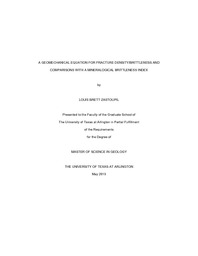| dc.description.abstract | As production of hydrocarbons from tight reservoirs becomes more prevalent, the need to understand fracture density and what can affect fracture density has become the goal of new research. In this study, fracture density is defined as the fracture surface area per volume (m-1), and is derived from strain energies and material properties of the rock. Brittleness is defined as the fracture density at a particular strain state.One purpose of the study is to use the dimensionless geomechanical equation, FdUaμ = A ν1-2ν + B, to test whether the strain conditions were constant from layer to layer. If they were, the data will plot as a straight line with a positive slope where A and B are related to the strain invariants. Fracture density measurements were taken in Millsap, TX, Baird and Clyde, TX and Midlothian, TX on outcrops using scan lines. Samples were collected and brought back to the Geomechanics Lab at UTA to measure material properties using P and S wave velocities. Density and porosity were measured via Mercury Injection at the Geology Lab at UTA. Weatherford Laboratories measured mineralogical percentages of the samples using XRD. These mineralogical percentages were used for fracture toughness estimates and forvcomparisons of the fracture density brittleness with the commonly used brittleness index derived from the Jarvie (2007) equation.Using the dimensionless equation above, the data from Millsap, TX plotted as a straight line with a correlation coefficient > 0.9 showing that the strain was constant from layer to layer in that area. The Baird and Clyde and Midlothian, TX data plotted as a line with a negative slope and poor correlation coefficients suggesting that the strain was not constant from layer to layer in those areas.Another goal of the study was to compare the fracture density brittleness using Fd = μUa (A ν1-2ν + B), with Jarvie's (2007) mineralogical brittleness index. In general, the two methods predict different layers to be the most brittle. The advantage of the geomechanical equation is that it produces results in fracture surface area per cubic meter compared to the XRD brittleness index, which is a dimensionless number. Knowing fracture density at a particular strain state may permit better hydraulic fracturing designs. Results show that the brittleness predicted by the two methods are significantly different, but accuracy of the two methods is not well constrained. | en_US |

